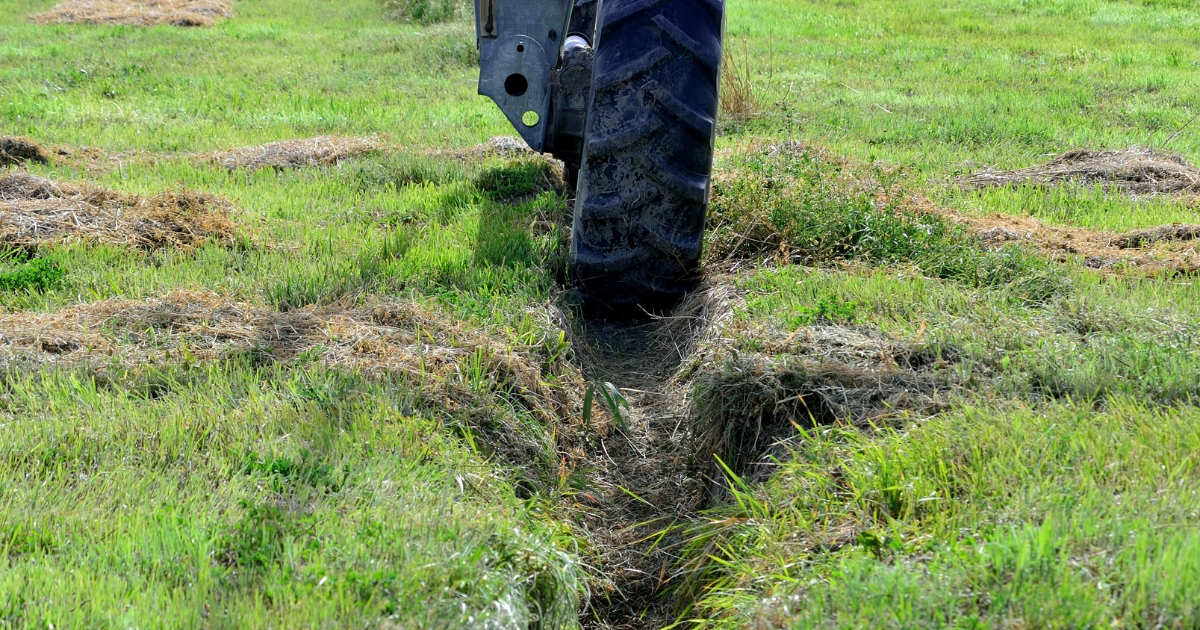
Category: Cooperative Extension

Stuck in a rut: Addressing the challenges of pivot tracks
May 29, 2023 Written by James Adkins, Associate Scientist and Irrigation Engineer
Between the inconvenience of bouncing across pivot tracks with the sprayer to the extreme frustration of a stuck pivot field, rutting is a challenge for every irrigation manager.
I have seen and done some rather sketchy things to avoid getting pivots stuck. From filling deep tracks with sand and gravel to building wooden track bridges to keeping and old spreader floor chain on hand to cross the bad spot, most solutions to fix a track after it has formed are temporary at best. The key to track management is preventing them from forming altogether. Prevention will require improvements in field drainage, adjustments to sprinkler packages, altered irrigation scheduling, or tire style changes.
Starting off the season with tracks filled and raised slightly above the surrounding field elevation will help avoid water ponding in the track early season. Whatever style track closer is used (specialized tool, a disc set to pull inward or a grader), be sure to pack the track with a tractor or the pivot itself while it is dry. Running the pivot around dry does not work as well as a tractor, as without water in the pipe, the machine weight is low. For those with specialized track closers with packing rollers, try to keep as much pressure on the packer as possible while still maintaining a finished grade above field elevation.
The extremely rutted spots will require to fill dirt to be imported. Packing sand tends to work the best, and try to avoid stone unless you are certain it will not impact any future tillage or cropping practices.
Keeping the instantaneous irrigation application rate or" soak time" below the soil infiltration rate will minimize the amount and depth of saturated soil and, thus, rutting potential.
Soil infiltration rate is predominately driven by soil type; however, minimizing compaction and no-till practices can improve infiltration on most soils. Soak time is a function of the nozzle type, nozzle location, system pressure and system flow rate. Any increase in a sprinkler's wetted diameter will reduce the application rate. A rotating or wobbling nozzle package will increase the soak time over a super spray or LDN-type nozzle package. Sprinklers mounted on top of the pipe, despite being more susceptible to wind and evaporation losses, will increase the "soak time" and reduce rutting. The outermost spans of a pivot are where the highest application rate occurs and have the greatest rutting potential.
A center-pivot needs as much floatation as possible, so larger tires are a first step. Typically, a 14.9 x 24 will provide significantly more floatation than an 11.2 x 24; however, the rut will be wider and harder on equipment. 16.9 x 26's work well but are expensive and leave an even wider rut.
11.2 x 38's work well in most conditions, providing more ground clearance while leaving a narrower track, but the increased cost may not be worth it. Keep in mind the radials provide for more tire flex at a lower minimum pressure which will increase surface area and floatation.
Despite the tire size, the ag lug pattern is overwhelmingly a detriment to rut mitigation. The angled lug of a chevron pattern ag tire was designed for tractors to push unstable soil to the side and contact a firm tractive surface. The squishing of soil out the side is greatly amplified with any wheel slip. The chevron design works great for tractors pulling a load in a slightly wet field, but as things move toward soil saturation, things quickly escalate and form deep ruts. If a pivot is going to always be in one direction, mounting both tires to run with the tread backward is a cheap first step. With a backward tire tread, wheel slip will pull soil to the center instead of pushing it out to the side. In other circumstances switching to a tire with a straight cleat or non-directional will allow good traction without pushing soil to the side.
Non-directional tires are available from a range of manufacturers, including recaps, and one should look for a straight-shouldered tire to get the maximum benefit.
Airless tires have been on the market for several years and have achieved varying degrees of success.
Most experiences with plastic tires have not been positive, as they have zero tire flex to add floatation and unknown longevity. In my experience, Zimmatic NFTrax has been excellent at minimizing rutting but can be hard on old high-wear gearboxes. I would expect Valley's Revolution Airless, Evolution Wheel's EWRS and yet-to-be-released Sharkwheel tire to perform much like the NFTrax, given the design. The cleat tire like Agri-Trac, RAFFT Tracks and others provide a lower-cost alternative for straight cleats with more floatation but lack the advantages of being airless.
